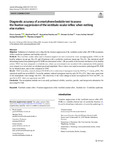2020-07-08Zeitschriftenartikel
Diagnostic accuracy of a smartphone bedside test to assess the fixation suppression of the vestibulo-ocular reflex: when nothing else matters
Gandor, Florian
Tesch, Manfred
Neuhauser, Hannelore
Gruber, Doreen
Heinze, Hans-Jochen
Eberssbach, Georg
Lempert, Thomas
Objective
Validation of a bedside test to objectify the fixation suppression of the vestibulo-ocular reflex (FS-VOR) in patients with a cerebellar syndrome and healthy controls.
Methods
The vestibulo-ocular reflex and its fixation suppression were assessed by video-nystagmography (VNG) in 20 healthy subjects (mean age 56 ± 15) and 19 patients with a cerebellar syndrome (mean age 70 ± 11). The statistical cutoff delineating normal from pathological FS-VOR was determined at the 2.5th percentile of the normal distribution of the healthy cohort. VNG was then compared to a bedside test, where eye movements were recorded with a smartphone while patients were rotated on a swivel chair at a defined speed and amplitude. These videos were rated as normal or pathological FS-VOR by six blinded raters, and results compared to VNG.
Results
VNG in healthy controls showed FS-VOR with a reduction of nystagmus beats by 95.0% ± 7.2 (mean ± SD). The statistical cutoff was set at 80.6%. Cerebellar patients reduced nystagmus beats by only 26.3% ± 25.1. Inter-rater agreement of the smartphone video ratings was 85%. The sensitivity of the video ratings to detect an impaired FS-VOR was 99%, its specificity 92%. Inter-test agreement was 91%.
Conclusion
The smartphone bedside test is an easily performed, reliable, sensitive, specific, and inexpensive alternative for assessing FS-VOR.
Files in this item

